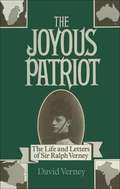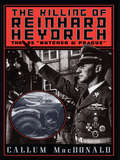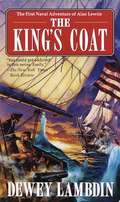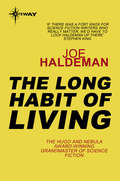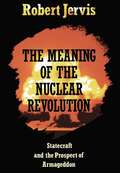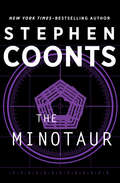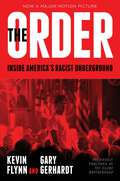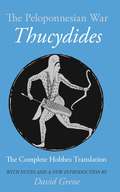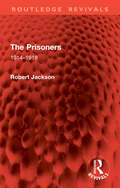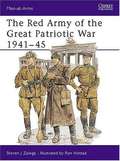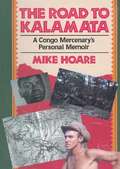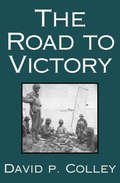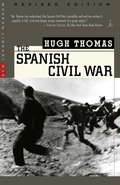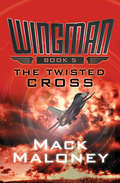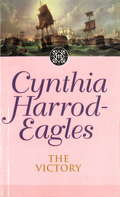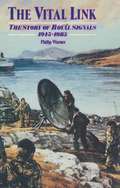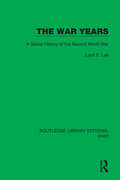- Table View
- List View
The Joyous Patriot: The Life and Letters of Sir Ralph Verney
by David VerneyRalph Verney was born in 1879. His grandfather, Sir Harry Verne, had married as his second wife, Parthenope, Sister of Florence Nightingale, who was Ralph's Godmother. In 1900 he joined the Riffle Brigade and was sent to South Africa where the Boer War was then in progress. A dutiful son, he wrote regularly to his parents, describing every detail of his daily life. Fortunately these letters have survived and have now been edited for publication by Ralph's own son, David. Quite apart from the intrinsic interest of what the letters actually say, they have another rarer quality, in that they lay bare the standards by which a young man of aristocratic birth was then guided. Old-fashioned they may sound, but not a few still regret their passing. In 1907 Ralph became ADC to Lord Chelmsford, then Governor of Queensland, and two years later falls in love and marries Nita Walker, daughter of a distinguished Australian banker and politician. Now some of Nita's letters enliven the correspondence and soon a baby is on the way. So too is the First World War and Ralph finds himself back with his regiment in France, where he has what must, ironically, be regarded as the good fortune of the wounded. At the end of his first volume we leave him on the road to recovery and to India where he will shortly rejoin Lord Chelmsford.
The Killing of Reinhard Heydrich: The SS "Butcher of Prague"
by Callum MacdonaldIf anyone warranted assassination during World War II, the man to know was Reinhard Heydrich (1904?1942)?chief of the security police, rabid anti-Semite, architect of the Final Solution, ruthless over
The King's Coat: The Naval Adventures of Alan Lewrie (Alan Lewrie Naval Adventures #1)
by Dewey LambdinThe very first Alan Lewrie naval adventure. 1780: Seventeen-year-old Alan Lewrie is a brash, rebellious young libertine. So much so that his callous father believes a bit of navy discipline will turn the boy around. Fresh aboard the tall-maste^ Ariadne, Midshipman Lewrie heads for the war- torn Americas, finding—rather unexpectedly— that he is a born sailor, equally at home with the randy pleasures of the port and the raging battles on the high seas. But in a hail of cannonballs comes a bawdy surprise.... "Fast-moving at sea, nicely lewd ashore, a hugely likable hero, a huge cast of sharply drawn supporting characters; there's nothing missing.
The Long Gray Line
by Rick AtkinsonBased on the true story of Marty Maher, a humble Irish immigrant who rose through the ranks to become one of West Point's most beloved instructors. A rousing tribute to a remarkable man & his way of life.
The Long Habit of Living
by Joe HaldemanMore even than space travel, the Stileman Process had altered twenty-first century life. The most complex of medical miracles, it ensured that every ten years or so, the ailing aging body could be restored to youthful vigour and health.There was a catch of course. The cost. Every ten years or so you have to come up with £1,000,000 minimum or die.For Dallas Barr, one of the oldest men on earth, it was that time again. It was while he was casting around for that vital next million that he came across Maria, a woman from - literally - a previous life. And made two major discoveries.Not all Stileman 'immortals' were born - or created - the same. And someone is trying to kill them. All of them.
The Meaning of the Nuclear Revolution: Statecraft and the Prospect of Armageddon (Cornell Studies in Security Affairs)
by Robert JervisRobert Jervis argues here that the possibility of nuclear war has created a revolution in military strategy and international relations. He examines how the potential for nuclear Armageddon has changed the meaning of war, the psychology of statesmanship, and the formulation of military policy by the superpowers.
The Minotaur (Jake Grafton #2)
by Stephen CoontsFrom a New York Times–bestselling author: A military pilot is entangled in the hunt for a Cold War spy selling high-tech secrets to the USSR. Navy pilot Jake Grafton flies fighter jets with ice water in his veins. But when he&’s assigned a desk job in the Pentagon as the head of a top-secret stealth bomber program, his nerve is tested as never before. Colleagues start dying mysteriously, test flights are sabotaged, and the program is threatened at every level. If Grafton can&’t infiltrate a web of espionage and counterespionage centered on the deadly traitor code-named the Minotaur, he stands to lose much more than just his career. The Minotaur is an exhilarating thriller revealing the complexities of military technology R&D by the acclaimed author of Flight of the Intruder, The Red Horseman, and other novels. In the words of Tom Clancy, &“Stephen Coonts, like Jake Grafton, just keeps getting better.&” This ebook features an illustrated biography of Stephen Coonts, including rare photos from the author&’s personal collection.
The Minotaur (Jake Grafton #2)
by Stephen CoontsFrom a New York Times–bestselling author: A military pilot is entangled in the hunt for a Cold War spy selling high-tech secrets to the USSR. Navy pilot Jake Grafton flies fighter jets with ice water in his veins. But when he&’s assigned a desk job in the Pentagon as the head of a top-secret stealth bomber program, his nerve is tested as never before. Colleagues start dying mysteriously, test flights are sabotaged, and the program is threatened at every level. If Grafton can&’t infiltrate a web of espionage and counterespionage centered on the deadly traitor code-named the Minotaur, he stands to lose much more than just his career. The Minotaur is an exhilarating thriller revealing the complexities of military technology R&D by the acclaimed author of Flight of the Intruder, The Red Horseman, and other novels. In the words of Tom Clancy, &“Stephen Coonts, like Jake Grafton, just keeps getting better.&” This ebook features an illustrated biography of Stephen Coonts, including rare photos from the author&’s personal collection.
The Minotaur (Jake Grafton #3)
by Stephen CoontsA Soviet mole is riding Pentagon secrets at twice the speed of sound... Fighter-jock Jake Grafton has survived his share of airborne death duals. Now he's grounded. As head of the Top-Secret Athena Project, he's now in charge of developing the Navy's next-generation attack aircraft -- a carrier - launched stealth version of the A-6 Intruder. But deep within the Labyrinth of the Pentagon, a cunning Soviet network is trashing U.S. security. Behind it it is the ultimate spymaster called The Minotaur: his sights are on Jake's aircraft... and his plans are for one last kill.
The Order: Inside America's Racist Underground
by Kevin FlynnSoon to be a major motion picture! Originally published as The Silent Brotherhood, uncover the chilling depths of America&’s racist underground with this investigative true crime masterpiece exposing the inner workings of white supremacist militias and domestic terror groups.Two courageous investigative journalists deliver an insider&’s account of the &“silent brotherhood&”—the most dangerous radical-right hate group to surface since the Ku Klux Klan. They claim to be patriots, as American as apple pie, but they are this nation&’s deadly brotherhood—hate groups that package their alienation against the federal government under such names as the Aryan Nation, the Order, and other white supremacist militias. The group attracts seemingly average citizens with their call for pride in race, family, and religion and their mission to save white Christian America. They spout anti-Black, antisemitic, neo-Nazi rhetoric, and their grievances have festered into full-blown paranoia and a call for an all-out race war. The Order reveals in terrifying detail how the group became criminals and assassins in their effort to establish an Aryan homeland.
The Peloponnesian War: The Complete Hobbes Translation
by David Grene Thomas Hobbes ThucydidesThomas Hobbes's translation of Thucydides brings together the magisterial prose of one of the greatest writers of the English language and the depth of mind and experience of one of the greatest writers of history in any language.
The Power Of One: Young Readers' Edition (Popular Penguins Ser.)
by Bryce CourtenayIn 1939, as Hitler casts his enormous, cruel shadow across the world, the seeds of apartheid take root in South Africa. There, a boy called Peekay is born. His childhood is marked by humiliation and abandonment, yet he vows to survive and conceives heroic dreams, which are nothing compared to what life actually has in store for him. He embarks on an epic journey through a land of tribal superstition and modern prejudice where he will learn the power of words, the power to transform lives and the power of one.
The Prisoners: 1914–1918 (Routledge Revivals)
by Robert JacksonOriginally published in 1989, Robert Jackson’s outstanding book revealed a whole area of wartime experience which had been neglected. It was the first book of its kind to cover all aspects of the years behind the wire in Prisoner of War (POW) camps during the First World War. The author drew extensively on unpublished personal narratives from the archives of the Imperial War Museum to provide a broad cross-section of life in the POW camps. He also dealt with the work of the Red Cross, internment in neutral countries, treatment of prisoners immediately after capture and escapes.
The Red Army of the Great Patriotic War, 1941-45
by Steven J. ZalogaThe German invasion in 1941 led to a series of staggering defeats for the Russians. In the first five months of fighting, the Soviets lost about four million men, amounting to 80 per cent of the total strength of the ground forces at the time of the outbreak of the war. Yet the Red Army managed to hold on. The Soviets had been steadily growing throughout in capability and effectiveness, and after the smashing of the German offensive at the battle of the Kursk salient, they were never again seriously checked, advancing to the ruins of Berlin itself. This title examines the organisation, equipment and uniforms of the Red Army of the Great Patriotic War.
The Road to Kalamata: A Congo Mercenary's Personal Memoir
by Mike HoareThe Road to Kalamata is the real-life adventure story of the 4 Commando team of mercenary soldiers, as told by their leader, Col. Mike Hoare. At the close of 1960, the newly formed independent state of Katanga in central Africa recruited Hoare and his team to suppress a rebellion by the Baluba, a fierce tribe of warriors rumored to be cannibals and known to torture and dismember any enemy soldiers unlucky enough to be captured. The events recounted in this book occurred in the Congo during the Katanga campaign of 1961. With insight that only an officer with extensive battlefield experience can bring to this subject, Colonel Hoare chronicles the metamorphosis of 4 Commando from a loose assembly of individuals into a highly organized fighting unit, while also taking the reader inside the minds and hearts of men who sell their military skills for money. What emerges is a compelling and complex portrait of genuine adventurers, "a breed of men which," writes Hoare, "has almost vanished from the face of the earth." Paladin Press is pleased to make available once again this engaging, colorful and thoughtful account, originally published in 1989, complete with a new foreword by the 20th century's most famous mercenary and one of its most eloquent storytellers.
The Road to Victory: The Untold Story Of Race And World War Ii's Red Ball Express
by David P. ColleyThis &“important contribution to WWII history&” reveals the trucking convoy, manned by unsung black soldiers, who helped defeat the Nazis (Publishers Weekly). After the D-Day landings in Normandy, Allied forces faced a golden opportunity—and a critical challenge. They had broken across enemy lines, but there was no infrastructure to supply troops as they pushed into Germany. The US Army improvised a perilous solution: a convoy of trucks marked with red balls that would carry desperately needed ammunition, rations, and fuel deep into occupied Europe. The so-called Red Ball Express lasted eighty-one days and, at its height, numbered nearly six thousand trucks. The mission risked attacks by the Luftwaffe and German ground forces, making it one of the GIs&’ most daring gambits. Without the soldiers who successfully executed this operation, World War II would have dragged on in Europe at a terrible cost of Allied lives. Yet the service of these brave drivers, most of whom were African American, has been largely overlooked by history. The first book-length study of the subject, The Road to Victory chronicles the exploits of these soldiers in vivid detail. It&’s a story of a fight not only against the Nazis, but against an enemy closer to home: racism.
The Scent of Snowflowers: A Chronicle of Faith, Hope and Survival in War-ravaged Budapest
by R. L. KleinThe true story of a Jewish family and the Gentiles who hid and protected them during World War II in Budapest.
The Spanish Civil War: Revised Edition (Pelican Ser.)
by Hugh ThomasA masterpiece of the historian's art, Hugh Thomas's The Spanish Civil War remains the best, most engrossing narrative of one of the most emblematic and misunderstood wars of the twentieth century. Revised and updated with significant new material, including new revelations about atrocities perpetrated against civilians by both sides in this epic conflict, this "definitive work on the subject" (Richard Bernstein, The New York Times) has been given a fresh face forty years after its initial publication in 1961. In brilliant, moving detail, Thomas analyzes a devastating conflict in which the hopes, dreams, and dogmas of a century exploded onto the battlefield. Like no other account, The Spanish Civil War dramatically reassembles the events that led a European nation, in a continent on the brink of world war, to divide against itself, bringing into play the machinations of Franco and Hitler, the bloodshed of Guernica, and the deeply inspiring heroics of those who rallied to the side of democracy. Communists, anarchists, monarchists, fascists, socialists, democrats -- the various forces of the Spanish Civil War composed a fabric of the twentieth century itself, and Thomas masterfully weaves the diffuse and fascinating threads of the war together in a manner that has established the book as a genuine classic of modern history.
The Story of the Vietnam Veterans Memorial (Cornerstones of Freedom)
by David K. WrightThe behind-the-scenes story of how and why the Vietnam Veterans Memorial was built in Washington, D.C.
The Titan Game
by Niven BuschThe rules of the Titan Game are as deadly as gas and as devious as fog: torturers can become esteemed customers, bystanders are seldom innocent, a man's worst enemy is often himself...
The Twisted Cross: The Twisted Cross, The Final Storm, Freedom Express, Skyfire (Wingman #5)
by Mack MaloneyWith the Russians vanquished, fighter pilot Hawk Hunter sets his sights on an old enemy poised for trouble in Panama. A Boeing 727 is making a routine charter flight out of Football City—formerly known as St. Louis—when three F-4 Phantoms appear on its tail and open fire. No match for the lightning-quick Phantoms, the 727&’s pilot is about to give up when his assailants explode in mid-air, becoming the latest casualties of Hawk Hunter, the Wingman. Hunter is the greatest fighter pilot the world has ever known. Most recently, he brought the United States back from the brink of extinction. But a new threat has emerged from the south: An army of neo-Nazis has seized control of the Panama Canal, and they&’re armed to the teeth. Their hateful ideology may be decades out of date, but these jackbooted killers have firepower that is state-of-the-art. The Twisted Cross is the fifth book of the Wingman series, which also includes Wingman and The Circle War.
The Victory: The Morland Dynasty, Book 12 (Morland Dynasty #12)
by Cynthia Harrod-Eagles1803: Napoleon is poised to invade England, with only Nelson's weather-beaten ships in his way, but the French fleet are not the only threat to the fortunes of the Morland family.In the North of England, Mary Ann's relationship with the missionary, Father Rathbone, introduces her to the stark realities of life in plague-torn Manchester.In the South, Lucy's lover, Weston, is assigned to the blockade of Brest, while her neglected husband, Chetwyn, finally finds love in an affair which threatens him with disgrace and ruin.From the fashionable salons of Beau Brummell's London, to the shot-torn docks at Trafalgar, the Morlands face danger and personal tragedy, as well as love and fulfilment.
The Victory: The Morland Dynasty, Book 12 (Morland Dynasty #12)
by Cynthia Harrod-Eagles1803: Napoleon is poised to invade England, with only Nelson's weather-beaten ships in his way, but the French fleet are not the only threat to the fortunes of the Morland family.In the North of England, Mary Ann's relationship with the missionary, Father Rathbone, introduces her to the stark realities of life in plague-torn Manchester. In the South, Lucy's lover, Weston, is assigned to the blockade of Brest, while her neglected husband, Chetwyn, finally finds love in an affair which threatens him with disgrace and ruin.From the fashionable salons of Beau Brummell's London to the shot-torn docks at Trafalgar, the Morlands face danger and personal tragedy, as well as love and fulfilment.
The Vital Link: The Story of Royal Signals, 1945–1985
by Philip WarnerTo maintain the link of communication between battlefields and HQ, between commanders and soldiers, between physically distant Corps is the vital job of the Royal Signal. But the responsibility of the Signals extends beyond the logistical requirements of inter-personal contact Electronic Intelligence and Electronic Warfare are major departments within the organisation, each of which supports the other. The Vital Link examines these diverse aspects and traces the complex developments in techniques, technology and signals tactics since the Second World War. The book, however, is more an historical story then an exhaustive tract for reference purposes. It records the growth of the Signals through its people, the 'high quality' ordinary solder to the odd character, all of whom help to define the Royal Signals. With anecdotes from individual's achievements, both personal and professional, the history of this essentially military branch is presented in an accessible and enjoyable manner.
The War Years: A Global History of the Second World War (Routledge Library Editions: WW2 #42)
by Loyd E. LeeThis book, first published in 1989, combines the broad themes of diplomatic, political and military events with the human dimensions to form a major global analysis of the second world war. It also explains the difficulties encountered by the European powers in mobilising their colonies, and examines the economic and social reorganisation of the belligerents. It shows the impact of the collaboration of occupied peoples with the axis powers, and discusses in detail the resistance movements and the Holocaust. The book also looks at advances in science and technology, the application of social sciences to war, the intelligence services, and the arts.
